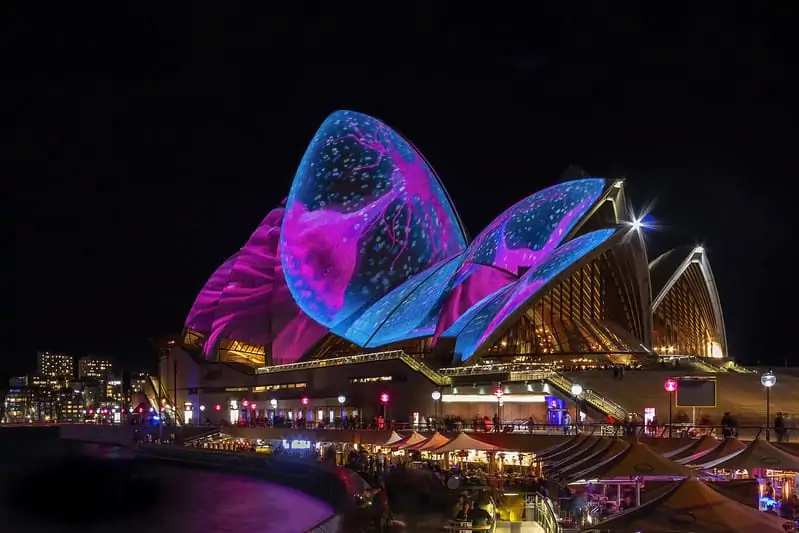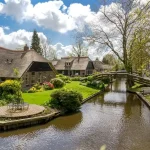What are the most beautiful places in Australia? If you’re a restless soul with a passion for exploration and a love for nature’s finest spectacles, Australia is a destination you can’t overlook. Dubbed the “land of kangaroos” and home to many remarkable “firsts,” Australia is a dream worth chasing. Here, you’ll witness jaw-dropping landscapes—from lively coastal cities brimming with culture to vast sandy expanses, ancient rainforests, and some of the world’s most stunning natural wonders. Narrowing down the top 10 scenic spots in Australia isn’t easy amid such abundant beauty, but drawing from travel experience, here’s a list of must-see Australian wonders you should visit at least once in your lifetime.
1. Sydney Opera House
It’d be a glaring omission to talk about Australia’s scenic beauty without mentioning the Sydney Opera House. Perched at the renowned Sydney Harbour, this architectural marvel embodies the country’s sophisticated design legacy. Crafted by Danish architect Jørn Utzon, its design mimics a seashell—or, more precisely, sails billowing toward the sea. Some see it as a symbol of Australia’s bold, modern, and civilized rise.
Spanning 1.8 hectares, 183 meters long, and 120 meters wide, the Opera House’s roof is clad with 1.056 million Swedish-made tiles. Its centerpiece is one of the world’s most famous opera theaters. Beyond performances, it’s a versatile venue hosting weddings, conferences, and events, with five theaters, six bars, five studios, four restaurants, and souvenir shops. Each year, millions of visitors flock here, joined by musicians, artists, and photographers who find inspiration in its grandeur.
From Sydney Harbour, the sight of the coastline framed by parks and gardens, blending with the Opera House’s sails and the Sydney Harbour Bridge, is a captivating Australian scene. Especially at night, the building glows with a magical splendor. During major holidays, it doubles as a stage for dazzling fireworks, leaving lasting impressions of Sydney’s charm. In 2007, it earned UNESCO World Heritage status, cementing its place as Australia’s most iconic landmark and a globally treasured structure.
2. Great Barrier Reef Marine Park

Another must-visit is the Great Barrier Reef Marine Park, a sprawling multifunctional marine haven supporting tourism, commerce, fishing, recreation, and research. Stretching along Queensland’s coast, it boasts over 3,000 coral reefs and bays across numerous islands, housing some of the planet’s most exquisite coral formations. Representing 10% of the world’s coral reefs, it’s a thriving habitat for thousands of vibrant tropical fish, dolphins, sea turtles, rays, marine mammals, algae, and mollusks. This biodiversity weaves a rich, complex ecosystem unlike any other.
Listed among the seven natural wonders of the world, the Great Barrier Reef offers unforgettable experiences. To see the corals up close, hop on a boat, snorkel if you’re daring, or take a small plane for a bird’s-eye view. For a tamer adventure, observation stations provide stunning underwater vistas without the plunge.
3. Blue Mountains National Park
A UNESCO World Heritage site, Blue Mountains National Park lies 81 km west of Sydney, making it a perfect day trip. Named for the blue haze from its vast eucalyptus trees, this park safeguards over 664,000 acres of wilderness, featuring dramatic ridges, waterfalls, Aboriginal rock art, and 140 km of trails. It’s divided into six areas: Katoomba, Blackheath, Glenbrook, Lower Grose Valley, Mount Wilson, and the southern Blue Mountains range.
A standout feature is the “Three Sisters,” towering sandstone formations, alongside the world’s steepest scenic railway at Katoomba, descending into the Jamison Valley’s ancient rainforest via a tunnel. Skyways, cable cars, and walkways offer poetic, expansive views. Hiking, climbing, mountain biking, or horseback riding here promises thrilling adventures.
This park blends pristine rainforests, sheer cliffs, freshwater streams, waterfalls, and rolling forest ridges. Quaint villages dotting the mountains exude rustic charm, while galleries in places like Leura sell handmade crafts. Dining options abound, with spots like Darley’s Restaurant at Lilianfels and Tomah Gardens adding flavor to your visit.
4. Uluru-Kata Tjuta National Park
Australia’s scenic beauty shines through its diverse terrains, and Uluru-Kata Tjuta National Park is a prime example. Located in the Northern Territory, 1,431 km from Darwin and 440 km southwest of Alice Springs, it sits deep in the Red Centre desert—a sacred site for Aboriginal people with a cultural legacy spanning over 50,000 years.
Known for its twin rock formations, Uluru and Kata Tjuta, this park is a natural icon. Uluru, a massive, smooth quartzite rock with no vegetation, holds spiritual significance, with locals believing it embodies a turtle deity. Its iron oxide coating shifts colors under sunlight—from pale red at dawn to vivid hues at midday, then deep crimson or purple at dusk—earning it the nickname “five-hued mystic rock.”
Popular with climbers and campers, this park invites you to join local Aboriginal guides to uncover its cultural depth and witness its mesmerizing color changes.
5. Great Ocean Road
Hailed as the world’s most scenic coastal drive, Great Ocean Road unveils Australia’s oceanic splendor with every twist and turn. Stretching from Torquay to Warrnambool, it reveals endless white-sand beaches, lush forests, charming towns, and koalas perched in trees. Built by over 3,000 World War I veterans, this road doubles as a grand memorial to fallen soldiers.
Key stops include:
- Great Ocean Road Memorial Arch: A photo-worthy tribute to the veterans who built it.
- Bells Beach: A surfing haven with pristine waves, colorful hillside flora, and activities like paragliding or snorkeling.
- Twelve Apostles: Majestic limestone stacks rising from the sea in Port Campbell National Park, now down to eight due to erosion.
- Apollo Bay: A picturesque fishing village framed by hills and ocean, perfect for a seaside stroll or meal.
6. Kakadu National Park, Darwin
A UNESCO World Heritage site, Kakadu National Park is Australia’s largest and the world’s second-largest national park. This wilderness wonderland features monsoon rainforests, wetlands, gorges, rivers, ancient rock art, and incredible biodiversity. Its cliffs bear carvings like the Rainbow Serpent and X-ray-style art depicting hunters and animals.
With over 1,700 plant species—from “resurrection grasses” to eucalyptus lowlands—and unique trees like banyans, Kakadu teems with life. Cross the East Alligator River by ferry to spot crocodiles, birds, barramundi, and geese. Explore by car, boat, or trail, but avoid the rainy season (January–April) when flooding closes many areas.
7. Whitehaven Beach and Whitsundays
Australia’s beauty extends to its endless coastlines, and Whitehaven Beach in the Whitsundays stands out. The largest of 74 islands off Queensland, its 98% silica sand—soft as baby powder—stays cool even under the sun, ideal for barefoot strolls. Turquoise waters invite swimming, snorkeling, or sunbathing, while a trek to Hill Inlet’s lookout reveals swirling white sands and blue tides in a mesmerizing blend.
8. Melbourne Museum
In Carlton Gardens, the Melbourne Museum is Australia’s premier natural and cultural history museum and the Southern Hemisphere’s largest. Adjacent to the Royal Exhibition Building, it spans three floors with eight galleries. The top floor showcases over 1,200 artifacts tracing Melbourne’s growth, plus sporting icons like Phar Lap. Ground-floor exhibits include the Koori Voices story of Victoria’s First Peoples, a blue whale skeleton, and geological displays. An IMAX theater screens blockbusters and 3D documentaries.
Beyond exhibits, it offers the Sidney Myer Amphitheatre, free discovery centers, shops, and cafes with tasty treats.
9. Fraser Island
The world’s largest sand island and a UNESCO site, Fraser Island dazzles with white beaches, colorful cliffs, and lakes in shades of blue, green, and brown. Rainforests thrive atop sand, and wild dingoes roam. Rent a boat or camp to explore highlights like:
- Kingfisher Bay: A sunset spot with a pier bar.
- Lake McKenzie: A pristine freshwater lake with soft sand.
- Maheno Shipwreck: A rusted WWII relic visible at low tide.
- Hammerstone Sandblow: A vast dune stretching from forest to Lake Wabby.
10. Lake Hillier (Western Australia)
Lake Hillier, off Middle Island near Esperance, stuns with its vivid pink hue—a natural marvel whose cause remains debated (perhaps carotenoid-rich algae or salt-loving microbes). Framed by a sandy rim and dark green eucalyptus forests, this lake is a striking Australian gem worth exploring.
Frequently Asked Questions About Australia’s Scenic Wonders
What’s Along Great Ocean Road?
From Torquay to Warrnambool, you’ll encounter the Memorial Arch, Bells Beach, Twelve Apostles, Apollo Bay, and more.
When’s the Best Time to Visit Australia?
September to March or March to May offer mild weather and lush scenery, ideal for outdoor exploration.










